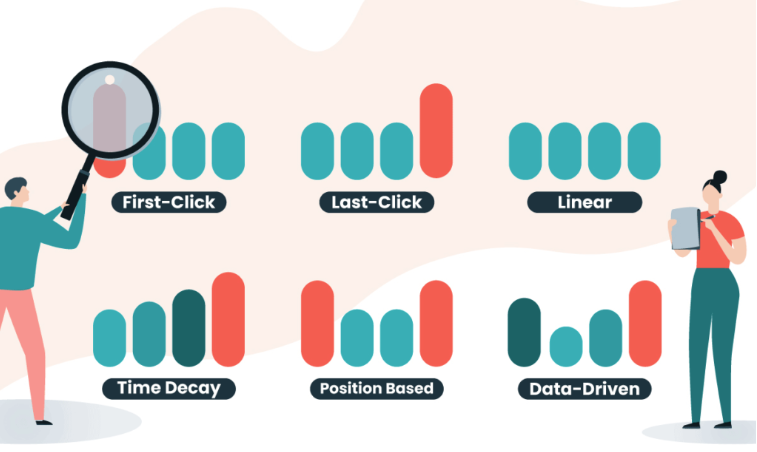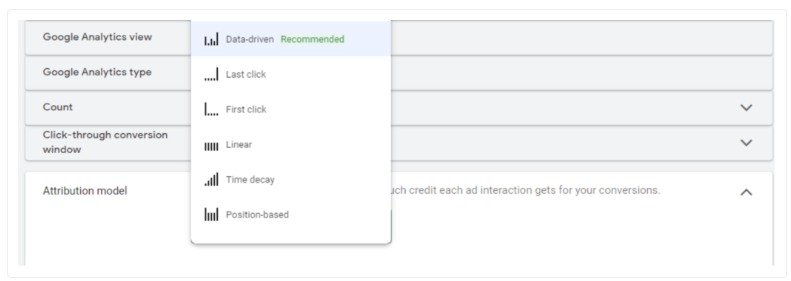When designing your ad campaigns, it can be easy to overlook your attribution model. After all, many people running ads don’t even really know what an attribution model is. Of course, it could slip under the radar!
There are six attribution models available for Google Ads, and each one is a different way of deciding which ad (or ads) get “credit” for when a user converts.
Obviously, each user doesn’t fill out a survey saying “this ad made me buy your product more than this other ad,” so the attribution model helps decipher that as best as we can through proxy and inference.
Essentially, your attribution model helps you understand which ads and tactics are the most effective and, by extension, efficient.
The different attribution models and their benefits
Image Source: growthmindedmarketing.com
Now, there are six different attribution models, and the data-driven option is the default.
Including the data-driven model, there are six other attribution model options:
- Last click: Here, all the credit goes to the last ad upon which a user clicked before converting, plus the keyword associated with said ad. In ye olden times, this was the default.
- First click: This is the opposite, with the first clicked-on ad and keyword getting credit.
- Linear: Credit in this option is distributed equally among ad interactions and keywords.
- Time decay: This is a kind of adjusted version of linear attribution, wherein credit is given to all ad interactions, but is weighted to favor those that happened more recently than when the conversion happened.
- Position-based: Lastly, this favors both the first and last interactions, giving each (and their associated keywords) 40% credit, while the leftover 20% credit is given to the other ad interactions collectively.
The data-driven attribution model, meanwhile, takes into consideration your past data for the corresponding conversion type and then attributes credit accordingly. It’s easy to see why this is the default option. And, when in doubt, it has the most potential to be consistently useful, if you don’t have a specific reason to attribute conversions differently.
More about the benefits of the right attribution model
While the general gist of an attribution model’s helpfulness is pretty apparent, there are more in-depth benefits as well.
Of course, for starters, choosing the correct attribution model for your purposes helps you gain deeper insights into your customer base; the most applicable model will complement your advertising strategy so you can better understand the complexities of what makes certain approaches successful — or, just as importantly, what makes other approaches not.
In the past, advertisers defaulted to measuring their campaign’s success based on whatever ad was most recently clicked.
That model is still available via the “last click” option, but formerly having that as the default vastly oversimplified what was going right (or otherwise) in a campaign. As we know from the purchasing funnel visualization of the consumer journey, people don’t go from “not even knowing a product exists” all the way to “purchasing” just in the span of a minute, an hour, or even a day. Often people will take weeks or even months to decide to purchase.
Because of this, knowing which ad interactions helped convince them along the way is obviously extremely valuable. A more well-thought-out attribution model helps you understand your customers better, and adjust your strategy, advertising, and bidding accordingly.
Furthermore, because you can better understand your users and their journeys, this means you can reach them earlier. Solely relying on last-click attribution doesn’t give you any insight into the first 98% of the customer’s experience being made aware of your business until clicking on that last ad. Better earlier-stage insights allow you to adapt your ad strategy — whether for content, bidding, or other factors — and to better reach future users in these earlier stages too.
Essentially, you’re now getting a more comprehensive understanding, each step of the way.
Now you can focus on those more likely to benefit from your products or services, while not bugging other users who are less interested but who would be tagged otherwise with past attribution defaults.
But before we go! Where to switch to a different attribution model
Image Source: growthmindedmarketing.com
We’ll cut right to it: Your attribution model is chosen for each specific conversion goal.
(A sidenote: keep in mind that changing your conversion attribution model will also result in some changes to your campaign reporting page. If you think about it this makes sense because changing the attribution model changes the exact info that’s being reported back to you, but sometimes it can be jarring to see an interface change if you weren’t expecting it.)
Anyways: Simply go to the goals icon in your Google Ads account, then under the “conversions” drop-down menu, click the “summary” option. In the ensuing table, choose the conversion you’re focusing on and click “edit settings.”
Here you’ll see the option for “attribution model,” and from there you can choose one of the six.
There’s also a model comparison tool; this allows you to compare what your reports and ad interaction crediting would look like in one attribution model versus another.
This is also found under the goals icon, although you’ll then go to the “measurements” drop-down. There you’ll find the “attribution” option, and then on the menu on the left of the screen you’ll see “model comparison.” There will be a “dimension” drop-down, where you’ll see your options, and then you can click “compare” and “with.” Voila!
We think having these attribution options will really help those businesses who want to dive deeper into understanding both their existing customers and potential future ones.
Instead of just throwing everything you can at users based on what is really quite a small data point — whatever they most recently clicked — you can learn more about how people interact with your online marketing and thus both bring them more relevant, informative content and yourself more efficient resource expenditure. It’s a win-win.






